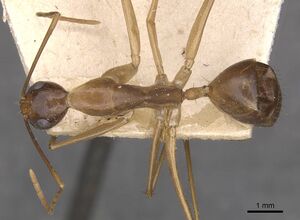Camponotus simulator
| Camponotus simulator | |
|---|---|

| |
| Scientific classification | |
| Kingdom: | Animalia |
| Phylum: | Arthropoda |
| Class: | Insecta |
| Order: | Hymenoptera |
| Family: | Formicidae |
| Subfamily: | Formicinae |
| Tribe: | Camponotini |
| Genus: | Camponotus |
| Species: | C. simulator |
| Binomial name | |
| Camponotus simulator Forel, 1915 | |
Identification
Keys including this Species
Distribution
Distribution based on Regional Taxon Lists
Australasian Region: Australia (type locality).
Distribution based on AntMaps
Distribution based on AntWeb specimens
Check data from AntWeb
Countries Occupied
| Number of countries occupied by this species based on AntWiki Regional Taxon Lists. In general, fewer countries occupied indicates a narrower range, while more countries indicates a more widespread species. |

|
Estimated Abundance
| Relative abundance based on number of AntMaps records per species (this species within the purple bar). Fewer records (to the left) indicates a less abundant/encountered species while more records (to the right) indicates more abundant/encountered species. |

|
Biology
Castes
Images from AntWeb
   
| |
| Syntype of Camponotus simulator. Worker. Specimen code casent0910099. Photographer Will Ericson, uploaded by California Academy of Sciences. | Owned by MHNG, Geneva, Switzerland. |
Nomenclature
The following information is derived from Barry Bolton's Online Catalogue of the Ants of the World.
- simulator. Camponotus (Dinomyrmex) simulator Forel, 1915b: 96 (s.w.) AUSTRALIA (Queensland).
- Combination in C. (Tanaemyrmex): Emery, 1925b: 90.
- Status as species: Emery, 1925b: 90; Taylor & Brown, 1985: 119; Taylor, 1987a: 15; Bolton, 1995b: 124; McArthur, 2014: 74.
Type Material
- Camponotus (Dinomyrmex) simulator Forel, 1915: Syntype, worker(s), Atherton, Queensland, Australia, Musee d'Histoire Naturelle Genève.
- Camponotus (Dinomyrmex) simulator Forel, 1915: Syntype, worker(s), Herberton, Queensland, Australia.
Unless otherwise noted the text for the remainder of this section is reported from the publication that includes the original description.
Description
Worker major, Length 11.5 mm. This form seems at first glance to be so similar to Camponotus (Myrmoturba) maculatus F.r. discors that one would take it to be the same species. The jaws therefore have only 6 teeth, the head is much longer than wide, the scape extends over the posterior margin of the head distinctly more than 1/3 of its length (scarcely a quarter with discors); the head is not so convex, the whole shape is narrower, the legs much longer, the thorax anterior still narrower and the node distinctly thicker. Colors, spines, sculpture and hair covering are but deceptively similar, above all the thorax is of a more regular shape, yellowish brown and the gaster is as brown in front as behind. The head is somewhat more strongly narrowing in front and the striations thinner.
Worker Minor. Length 8.5 mm. Head almost twice as long as wide in the middle, behind the eyes strongly narrowing, almost exactly with the race carin Emery des dorycus, behind somewhat more distinctly neck shaped narrowing, the sides therefore at least as convex. The long narrow thorax is much less convex, than with discors, from front to back evenly convex. The thick node is as long below as it is high, back and front convex, but the summit is much sharper, sharper than the major worker. The color is somewhat brighter than with the major worker and the whole shape much longer and narrower than with discors. The cheeks have single upstanding hairs (also with the major worker) which conform with discors.
Atherton, Herberton (Queensland). This form which appears to be deceptively similar to discors has no trace of erect or flat lying hair on the tibias or antennae, it decidedly conforms with Inezae For. but it is much smaller. Inezae has a few small hairs and no hair on the cheeks, also with the major worker the anterior head narrower and the posterior wider.
References
- Emery, C. 1925d. Hymenoptera. Fam. Formicidae. Subfam. Formicinae. Genera Insectorum 183: 1-302 (page 90, Combination in C. (Tanaemyrmex))
- Forel, A. 1915b. Results of Dr. E. Mjöbergs Swedish Scientific Expeditions to Australia 1910-13. 2. Ameisen. Ark. Zool. 9(1 16: 1-119 (page 96, soldier, worker described)

